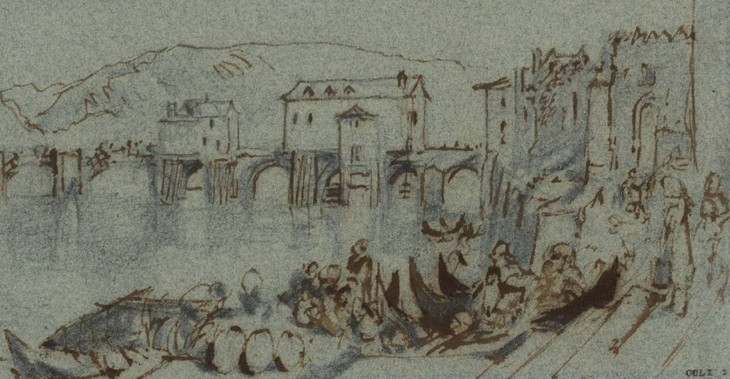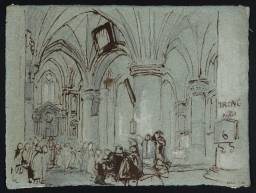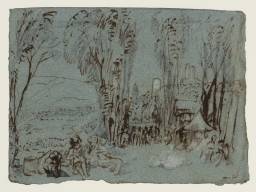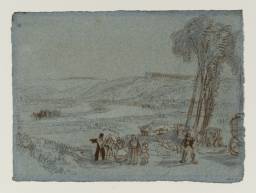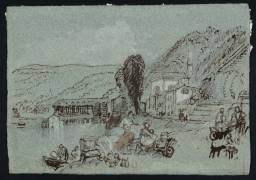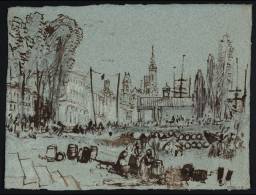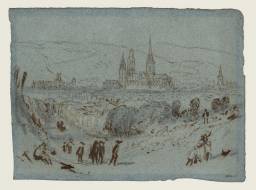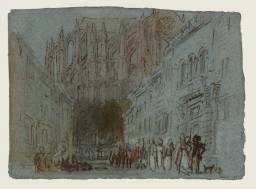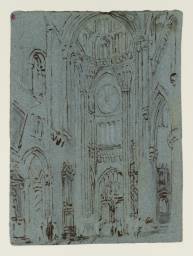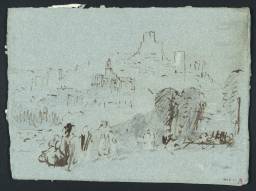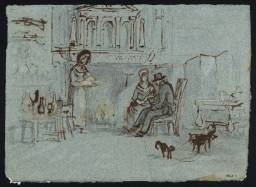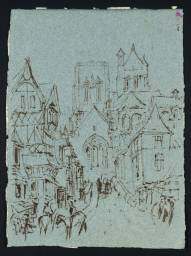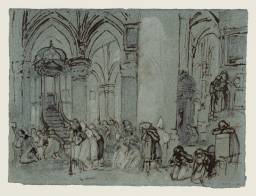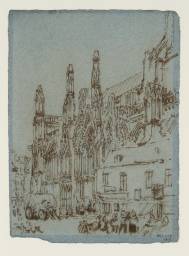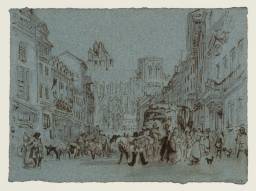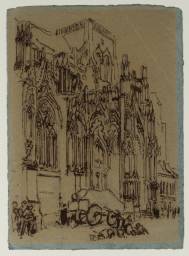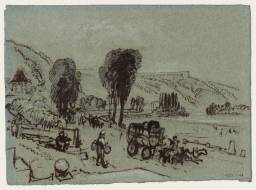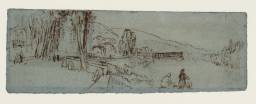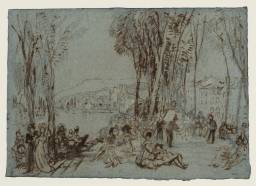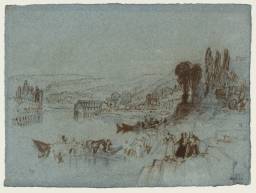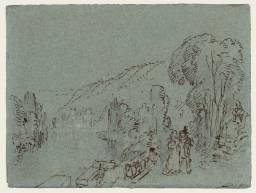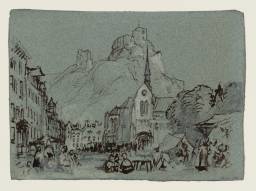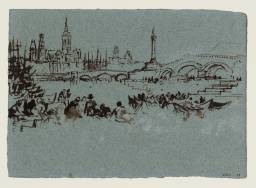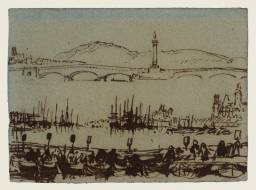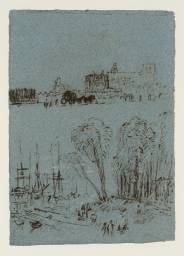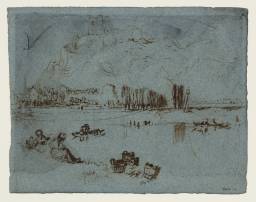From the entry
This section is primarily based on a proposed tour of northern France and the River Seine identified by Ian Warrell in the 1999 exhibition catalogue, Turner on the Seine, which is thought to have occurred between 1827 and 1829. The group of loose studies, all completed in pen and ink on blue paper with the occasional addition of gouache or chalk, had previously been given various different dates, but are unified in style and believed by Warrell to record a single journey on, and around, the Seine. The locations depicted include Rouen, Louviers, Evreux, Les Andelys, Vernon, Gisors, St-Germain-en-Laye and Marly-sur-Seine. While Turner’s exact itinerary is not known, Warrell has noted that he was probably relying on public transport, as some of the studies include a glimpse of the public coaches known as diligences. While this section is mostly based on Warrell’s grouping, a small group of similar works, also made in ink and gouache on blue paper, has been added to Warrell’s earlier selection (Tate ...
D24837–D24840, D24842, D24849–D24852, D24859, D24860, D24869, D24875, D24876, D24883, D24885–D24888, D24891, D24893–D24896, D24899, D24900, D24902–D24905, D24909, D24910, D24950, D24962, D24963, D24967, D24972, D40492, D41471
Turner Bequest CCLX 1, 2–4, 6, 13–16, 23, 24, 33, 39, 40, 47, 49–52, 55, 57–60, 63, 64, 66–69, 73, 74, 114, 126, 127, 131, 136
Turner Bequest CCLX 1, 2–4, 6, 13–16, 23, 24, 33, 39, 40, 47, 49–52, 55, 57–60, 63, 64, 66–69, 73, 74, 114, 126, 127, 131, 136
References
This section is primarily based on a proposed tour of northern France and the River Seine identified by Ian Warrell in the 1999 exhibition catalogue, Turner on the Seine, which is thought to have occurred between 1827 and 1829.1 The group of loose studies, all completed in pen and ink on blue paper with the occasional addition of gouache or chalk, had previously been given various different dates, but are unified in style and believed by Warrell to record a single journey on, and around, the Seine. The locations depicted include Rouen, Louviers, Evreux, Les Andelys, Vernon, Gisors, St-Germain-en-Laye and Marly-sur-Seine. While Turner’s exact itinerary is not known, Warrell has noted that he was probably relying on public transport, as some of the studies include a glimpse of the public coaches known as diligences.2
While this section is mostly based on Warrell’s grouping, a small group of similar works, also made in ink and gouache on blue paper, has been added to Warrell’s earlier selection (Tate D24839–D24840, D24842, D24909, D24967; CCLX 3–4, CCLX 6, CCLX 73, CCLX 131).
The studies themselves are characterised not only by their distinctive technique, but also by their particular approach to the subjects Turner saw during his travels along, and near to, the Seine. The river itself is often depicted, along with its bridges, and many of the sheets reveal a strong interest in the architecture of the region, with churches playing an important role both as main subjects for sheets, particularly in the case of the late Gothic church at Louviers (see the entry for Tate D24840; Turner Bequest CCLX 4), and as backdrops for street scenes. Travel is also well represented, with Paris day trippers shown visiting the Marly Machine (At Marly ?1827–9 ; D24837), and studies of the diligences used for getting from one point to another present. Most of the sheets are populated with people, whether they are the busy workers of the town concerned or figures looking over the same viewpoint that Turner depicts (see for example, Tate D24896; Turner Bequest CCLX 60). These figures bring a sense of daily life in northern France to the scenes, a human contrast to the sometimes-grand architectural backdrops.
The dating of the present grouping to 1827–9, although speculative, is supported by both stylistic analysis and contemporaneous changes along the Seine itself. As Warrell has argued, Turner’s use of pen and ink on blue paper is relatively rare within his practice, and Turner only made extended use of the medium one other time, during a visit to East Cowes Castle on the Isle of Wight in September 1827 while a guest of the castle’s architect and owner, John Nash (1752–1835).3 There he made various studies of his surroundings using a technique closely related to that seen on the studies included here (see the relevant section of the present publication catalogued by Matthew Imms). Turner’s gouache studies on blue paper made at Petworth in West Sussex are also somewhat similar, and these also relate to a visit of 1827. The Petworth studies do not, for the most part, relate to finished works; similarly, only a handful of the ink on blue paper studies catalogued here can be connected to relevant print projects, most obviously the 1834 Wanderings by the Seine volume of Turner’s Annual Tour print project.
In terms of dating the sheets in view of changing topography, Warrell points towards the presence the Château de la Chaussée at Bougival in the sketches (see Tate D24887; Turner Bequest CCLX 51), which was only visible in this form prior to a destructive fire some time before 1830.4 In terms of finding a starting point for the date range, it is important to note the presence of the newly constructed stone bridge at Rouen, the Pont d’Angoulème, in some of the studies (see, for example, Tate D24891; Turner Bequest CCLX 55). The bridge appears incomplete in Turner’s 1826 Rouen sketchbook (Tate D24077–D24106; Turner Bequest CCLV)5, so it stands to reason that the studies showing it as complete in the present grouping are later.
Of the speculated date range given here of 1827–1829, both Warrell and the present author consider 1827 the likeliest year of creation, principally due to the visual connections that can be drawn between these studies and those made on the Isle of Wight and, to a lesser extent, Petworth, that same year.
The format of some of the sheets included in this section is notable. Several are in a wide, panorama-like, format, which Turner tried out rarely. The studies are somewhat reminiscent in format and, to some extent, subject, of some of the oil sketches Turner had made on the River Thames some twenty years earlier (see, for example, Tate N02309; c.1807). More relevantly to the 1827–1829 dating of the present grouping, though, as Warrell has observed, Turner was working on wide-format landscape paintings to fit into the carved room at Petworth around this time, which could have influenced his decision to play with a wider format elsewhere in his practice (see, for example. Tate N00559).6 For drawings made in a panorama-like format catalogued within this section, see Tate D24859–D24860, D24894–D24896, D24899–D24900, D24904–D24905 (Turner Bequest CCLX 23–24, 58–60, 63–4, 68–69).
It is also important to note that although Turner rarely worked with it format, the panoramic-style format itself was popular in his day. Turner’s ownership of a copy of Thomas Girtin’s Twenty Views of Paris, which included prints made in the same height to width ratio seen in Turner’s Seine studies, seems particularly relevant.7 Interestingly, Girtin etched views of the Marly Machine and terrace at St-Germain-en-Laye, subjects also covered by Turner in a wide format within this section. Tate D24895 (Turner Bequest CCLX 59) presents a similar view to the etching and aquatint View from the Palace Terrace at St. Germain, for which Girtin’s preparatory drawing survives (British Museum, London8).
How to cite
Elizabeth Jacklin, ‘River Seine and Northern France Studies ?1827–9’, October 2018, in David Blayney Brown (ed.), J.M.W. Turner: Sketchbooks, Drawings and Watercolours, Tate Research Publication, November 2019, https://www

